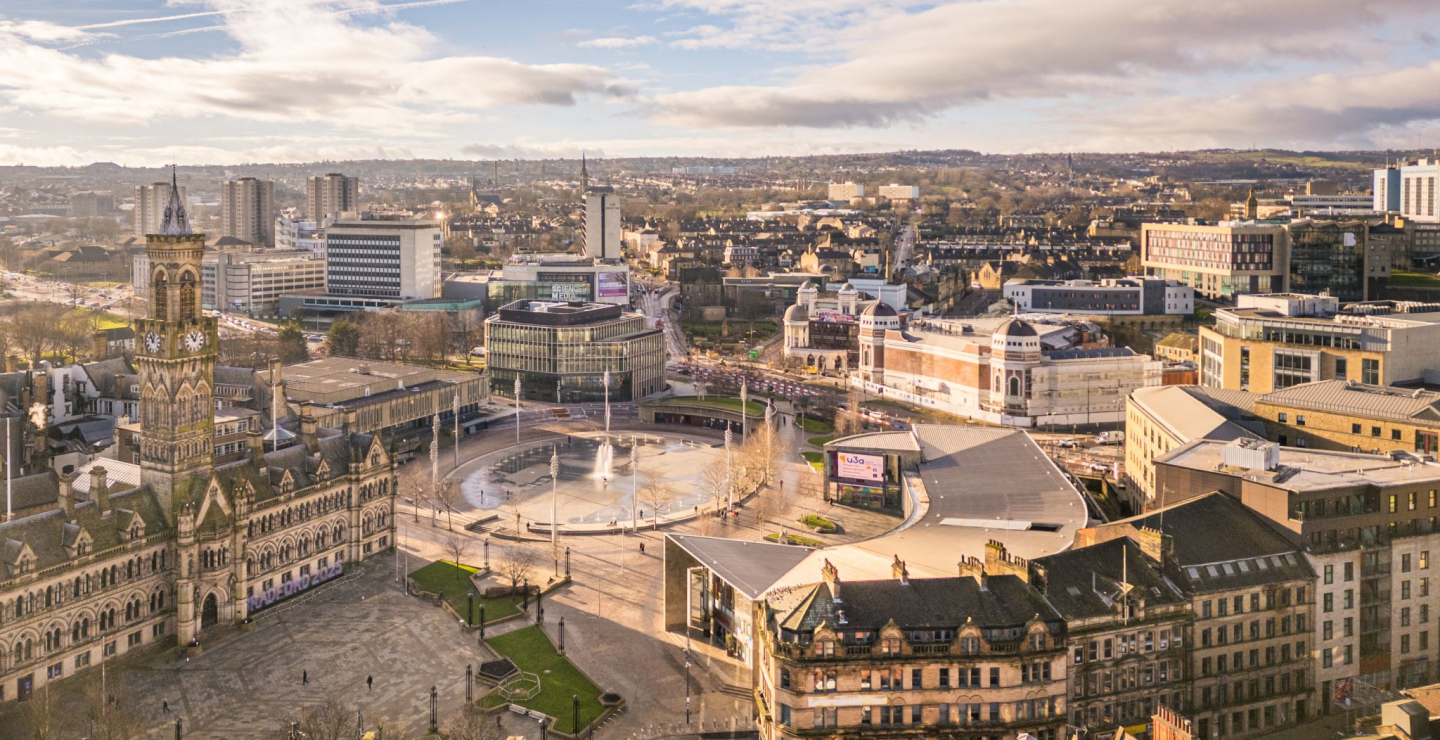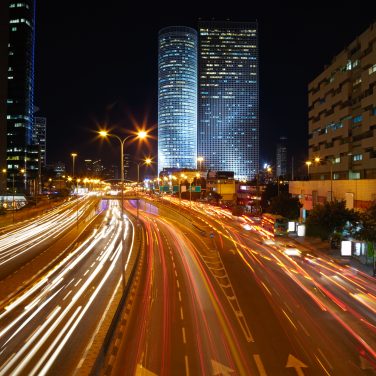£8 million saved. 6,000 tonnes of CO₂ cut. Bradford’s Smart Street Lighting Project has transformed the city’s infrastructure — and it’s just the beginning.
Situated in West Yorkshire, Bradford is one of England’s largest cities by population and home to a young, dynamic workforce. In 2019, it was named the UK’s ‘most improved place to live and work’ by PwC — the same year the council committed to becoming carbon neutral by 2038.
Facing rising energy costs, obsolete lighting materials, and ageing assets, Bradford City Council set out to modernise its street lighting. The goal: cut costs, reduce environmental impact, and build a future-ready network that could support a wide range of smart city applications.
Allun Preece, Principal Engineer (street lighting) at City of Bradford Metropolitan District Council, describes:
“When we embarked on our ‘Smart Street Lighting Project,’ we knew we wanted a non-proprietary CMS system to exploit as many new technologies as possible. Top of our list was: actionable insights that would lead to enhanced operations and services; improvements to citizen safety and wellbeing; and, ultimately, improvements that would deliver on the bottom line.”
The Project
The Bradford Smart Street Lighting Project set out to:
- Upgrade 56,000 streetlights to LEDs
- Reduce energy use and carbon emissions
- Halve maintenance costs
- Introduce a Central Management System (CMS)
- Deploy a LoRaWAN network to enable smart IoT technologies
In conjunction with the LED upgrade, the council chose Lucy Zodion’s Ki. smart city platform to control, monitor, and optimise the lighting network. Over four years, 59,000 Ki. nodes and multiple LoRaWAN gateways have been installed, giving the city a scalable, interoperable system for managing not just lighting — but any connected urban asset.
Results that speak for themselves
Since implementation, Bradford has:
- Cut street lighting energy use by 65%
- Reduced CO₂ emissions by 6,000 tonnes per year
- Halved maintenance costs
- Saved £8 million to date in energy bills and operational efficiencies
The project has also attracted national attention, with the BBC reporting on its environmental and financial achievements earlier this year.
Beyond lighting
The smarter controllability of the lighting system from a central point enabled the city to look at ways to provide joined-up support to emergency services, such as ‘light-up’ areas at the site of road accidents or highlighting access roads following night-time large crowd events.
Ryan Baum, Business Development Manager, comments:
“The Ki. platform, gives the City of Bradford MDC the flexibility to expand its existing infrastructure by adding urban city apps to reflect the city’s ever-evolving needs. With the potential to develop applications such as smart bins, smart parking, and EV charging locations.
On top of all this, Ki. delivered the ability to provide specific APIs (application programming interfaces, or in other words, technology that allows data, products, and processes to work together seamlessly) as well as programmable access to the data.”
A wide range of use cases
Once the system was demonstrated to districts, departments, and enterprises, ideas began flooding in about what data they would like to extrapolate. Allun details:
“The council has now identified a range of use cases, many of them sensor-based, which the Ki. system can support.”
Here are just a few examples of ways in which the council is using or now plans to use its new ‘smart’ network:
Adaptive lighting. With the CMS, the council can choose precisely when to switch each streetlight on or off and increase or reduce the light levels according to needs, such as weather conditions, seasonal lighting adjustments, and emergency events. This allows any number of switching or dimming levels, which can provide benefits to residents, pedestrians, and highway users in addition to further opportunities for energy savings and reducing maintenance issues such as fault detection.
Air quality. Like many cities, Bradford’s clean air zones are mandated by the central government. To effectively tackle the causes of air pollution, the City of Bradford MDC is looking to use LoRaWAN air monitoring sensors to ascertain pollution levels and identify areas of concern to implement corrective measures.
This can be achieved promptly, with the CMS providing notifications when the air quality drops below specified safe levels. The data can also be used to plan air quality improvements, drawing on historical datasets and analytics to provide forecasting models. This can then be input into public awareness campaigns to communicate the healthiest times to exercise or cycle.
On top of this, with the new CMS and network, the council can now deploy low-cost air pollution sensors. These can be relocated as new areas of concern are identified.
The sensors can also measure the impact of their interventions. The intervention can be as simple as green and red traffic signals, reducing the time people are sitting waiting in traffic. It is an easy task to do, but if you don’t have the data to back up the impact of that intervention, you can’t see if it is working.
Air quality metrics on their own only tell a part of the story, however. Working with other environmental data can reveal more. Humidity, for example, or traffic flow. The crucial point is that the CMS means the council can now tap into the smart city ecosystem’s full power to get an answer.
River level sensors. Our Drainage department identified another compelling use case: Trial River sensors have been installed to monitor water levels in the Bradford Beck, which flows under the city.
The data can be transmitted in real-time and can be extrapolated to predict and prewarn when water levels exceed a given value.
Road surface temperature monitoring. Another use case the council is looking to develop is monitoring road surface temperatures to assist in the forecasting for winter maintenance service delivery.
As the district has a mixture of rural and urban roads, some of which are particularly prone to freezing and heavy snowfall, it is extremely useful to know the difference in temperatures to enable the council to treat the roads accordingly.
Other use cases. IoT devices are especially useful for environmental monitoring. As part of the European Union, climate resilience projects’ SCORE’ and ‘Life Critical,’ the council and its partners are already using IoT devices to monitor air quality and flood risk in other areas.
With a local small business enterprise, Dales Land Net (which provides soil moisture and temperature monitoring services), SCORE provides monitoring using LoRaWAN devices at remote locations on Ilkley Moor for peatland restoration. The restoration work is being carried out by Moors for the Future on behalf of the Environment Agency and the Backstone Beck Natural Flood Management scheme.
Life Critical is also working to improve communities’ health and wellbeing by improving the quality of city parks. SCORE partner the University of Bradford, as part of a wider citizen science initiative on air quality in schools with Bradford Royal Infirmary research group Born in Bradford, provides IoT environmental monitoring in and around Horton Park on behalf of Life Critical.
This is measuring improvements that should help offset some of the local impacts of climate change on neighbouring communities.
A model for Net Zero cities
Bradford’s Smart Street Lighting Project demonstrates how investing in connected infrastructure can deliver:
- Immediate operational savings
- Long-term environmental benefits
- A scalable foundation for future smart city innovation
As Allun Preece, Principal Engineer for Street Lighting, notes:
“The new lights are half the price to maintain compared to the older lamps and powered by Ki., they will be able to report when faulty, taking critical faults and pulling them into planned maintenance schedules, reducing the need for time-consuming audits and street lighting reporting systems. Beyond these savings, we now have a fully scalable smart city solution, enabling us to add or remove applications to provide data insights as and when projects require.”
Bradford is now well on its way to meeting its 2038 carbon neutral target — and stands as benchmark of what’s possible when smart lighting becomes the backbone of a city’s digital transformation.
Find out more: Read the BBC’s coverage of Bradford’s Smart Street Lighting Project or visit https://www.lucyzodion.com/products/ki-gen-3-hardware/ to see how Ki. can help your city meet its Net Zero goals.
REFERENCES
[1] ‘Bradford most improved city in PwC’s Good Growth for Cities Index’, PWC, November 2019, https://www.pwc.co.uk/who-we-are/regional-sites/north/press-releases/bradford-most-improved-city-in-pwcs-good-growth-for-cities-index.html
[2[ GN12: The smart lighting column is available from the ILP, at:
https://theilp.org.uk/resources/
PROJECT CREDITS
Client: The City of Bradford Metropolitan District Council
Contractor: Amey


